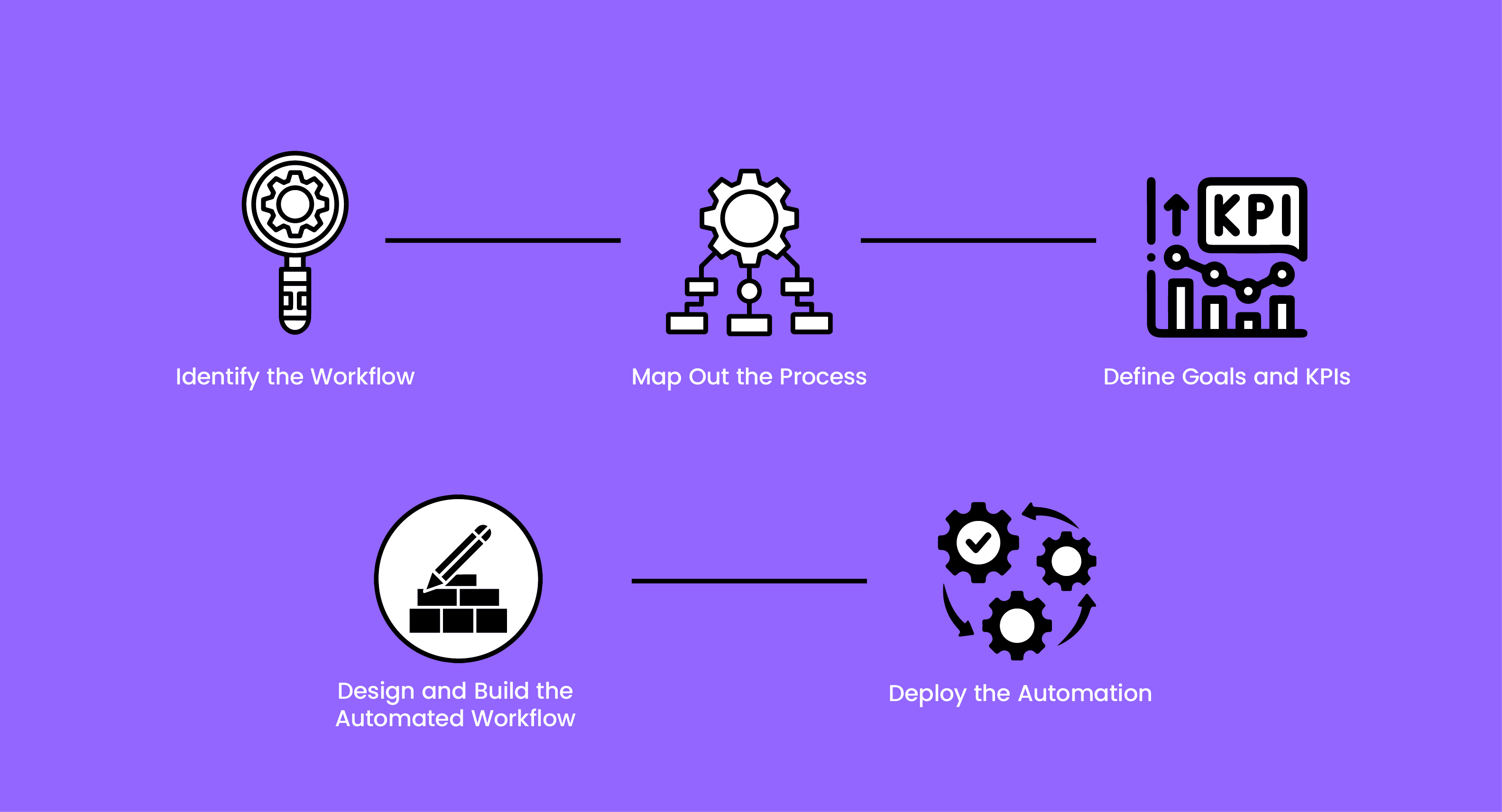In today’s competitive business environment, staying ahead requires a combination of strategies from exceptional customer service to accurate financial management. While companies rely heavily on their human resources, human errors can still create setbacks and raise concerns about overall efficiency.
This is where workflow automation software comes in, offering a smarter way to reduce mistakes and optimize performance. Whether it's automating marketing processes, financial tasks, or healthcare operations, automating workflows boosts productivity and ensures customers receive top-quality service.
This guide explores key areas where workflow automation can be applied, the best ways to implement it, future trends, and much more.
Overview of Workflow Automation

Workflow automation is the use of technology to perform repetitive tasks or processes with minimal human intervention. It streamlines operations by setting up rules, triggers, and actions that guide tasks from start to finish.
This not only saves time and reduces errors but also improves consistency and productivity. Businesses use workflow automation to simplify tasks like approvals, data entry, customer onboarding, and more.
Steps to Automate the Workflow
Here’s how you can implement automation software step-by-step:

Identify the Workflow
Start by selecting a process that is repetitive, time-consuming, and rule-based. Look for tasks that are prone to human error or delays.
Common examples include employee onboarding, invoice approvals, or customer service ticketing. Choosing the right workflow is key to maximizing the impact of automation.
Map out the Process
Visually outline each step of the workflow from start to finish. Include who is responsible for each task, what decisions are involved, and how data flows through the process.
Tools like flowcharts or process mapping software can help you create a clear picture. This step ensures no important actions are overlooked during automation.
Define Goals and KPIs
Determine what you want to achieve by automating the workflow, such as reducing processing time, minimizing errors, or improving consistency.
Set measurable Key Performance Indicators (KPIs) to track success, like approval time, error rate, or task completion rate. These goals will guide the automation design and help evaluate its effectiveness later.
Design and Build the Automated Workflow
Use your preferred automating workflows software to set up triggers, rules, and actions that match the mapped process. This could include automated task assignments, email notifications, or condition-based routing.
Make sure to test the workflow with sample data to catch any issues before going live. Involve stakeholders to ensure the system meets real-world needs.
Deploy the Automation
Once testing is complete and the workflow runs smoothly, roll it out for actual use. Train your team on how the new system works and provide support during the transition.
Monitor the workflow closely in the first few weeks to ensure it’s performing as expected. Make adjustments as needed to keep it optimized and aligned with your goals.
Benefits of Workflow Automation
Automating workflows offers numerous benefits, such as cost savings, scalability, performance tracking and etc. Some of the significant benefits are as follows:
Cost Savings
Automation software saves you on the cost by minimizing errors that could lead to hefty losses. Additionally, by optimizing resources and allocating efficiently, workflow automation ensures the resources are used in the best way, ensuring teams don't under- or overspend.
Enhanced Collaboration
Task tracker enhances collaboration and communication within a team. These tools provide a platform for dialogue, exchanging ideas, document sharing, coordination, and improving teamwork.
Scalability
Automating workflows enables businesses to manage growing workloads without the need to scale up their staff. It helps drive business expansion while maintaining high standards of quality and efficiency.
Performance Tracking
Workflow automation plays a vital role in tracking performance across teams and processes. It provides real-time visibility into task progress, bottlenecks, and completion rates.
With automated tracking, managers can easily monitor productivity, identify areas for improvement, and make data-driven decisions. This level of transparency helps ensure accountability and supports continuous optimization of workflows.
Uses of Workflow Automation
Workflow automation is your one-stop solution for diverse needs. This section explores how you can integrate it in various spheres:
Health Care
Workflow automation is increasingly being used in health care, where medical practitioners use workflow automation software to generate staff work schedules and on-call rotations.
By automating clinical documentation, healthcare organizations can free up more time for their staff to focus on providing healthcare services.
Tip to Implement in Healthcare:
Start small by automating repetitive administrative tasks like staff scheduling or patient intake forms using HIPAA-compliant software, then gradually expand to areas like documentation and billing.
Legal Automation
Automating workflows in legal aspects is equally important. It reduces the time spent on preparing documents, which is undesirable when decisions need to be made immediately.
Most commonly, automation is used in preparing non-disclosure agreements, writing developer agreements, handling counsel retention requests, and handling new clients.
Tip to Implement in Legal Automation:
Use template-based document automation tools to standardize repetitive legal documents like NDAs or contracts, and integrate them with e-signature platforms for faster approvals.
Marketing Automation
Integrating workflow automation software in digital marketing services is critically important. It enhances efficiency, productivity, streamlines work schedules, and reduces overlapping of tasks.
For instance, Marketing Operations Processes (MOPS) leverage workflow automation to manage marketing campaigns, streamline customer communication across various channels, and track metrics for performance analysis and reporting.
Tip to Implement in Marketing Automation:
Begin by automating email campaigns and lead-nurturing workflows using automation tools, and track campaign performance using built-in analytics dashboards.
HR Process Automation
Workflow automation software is used in HR processes, enhancing the overall efficiency and effectiveness of the HR system. By integrating robust HRM software, teams can automate routine tasks such as leave approvals and onboarding.
For instance, automating the travel approval process removes the need for multiple email exchanges between the employee, manager, HR, and finance departments.
Instead, the employee fills out a digital request form, which is automatically sent to the right stakeholders for approval and logged directly into the system.
Tip to Implement in HR Process Automation:
Implement a centralized HR platform that automates onboarding checklists, leave requests, and performance reviews, ensuring all HR actions follow a consistent and timely workflow.
Accounting Automation
The accounting department handles the intricate task of managing the financial records of firms. While doing it manually may cause numerous errors, automation software takes away these worries.
The accounting department generates reports, performs audits, makes purchases, etc. Workflow automation facilitates online tax filing, reducing the need to verify receipts that vendors and customers provide manually.
Additionally, when handling sensitive payment data, features like credit card encryption help secure financial transactions and protect customer information.
Tip to Implement in Accounting Automation :
Payroll processing is a key accounting task that greatly improves with workflow automation. With automation, the accounting team can access salary details, leave records, benefits, and reimbursements all in one centralized platform.
This streamlined setup allows them to handle payroll tasks efficiently and with minimal manual input.
Customer Service Automation
Customer service is the focal point where workflow automation can help significantly. From uploading customer data to sending a follow-up survey, a company has numerous opportunities to automate its customer service.
To protect sensitive customer information in these processes, businesses can also integrate anti-phishing tools and services to guard against fraud and cyber threats. By automating the repetitive task, your agent will get more time to deal with customers effectively.
Tip to Implement in Customer Service:
Adopt a help desk system like Zendesk or Freshdesk to automate ticket routing and schedule follow-ups, allowing agents to focus on complex customer needs.
Best Workflow Automation Tools
Workflow automation software is a digital tool that helps streamline and manage repetitive tasks by automating step-by-step processes within an organization. It enables users to set up triggers, actions, and rules, allowing tasks to progress automatically without manual intervention.
Most common workflow automation tools include:
- Jira
- ClickUp
- Nintex
- Zapier
- Asana
- Smartsheet
- Pipefy
These tools often integrate with other apps, send notifications, assign tasks, and monitor progress in real-time. Whether used in HR, marketing, finance, or IT, workflow automation software improves efficiency, reduces errors, and saves valuable time.
Future of Workflow Automation

The future of workflow automation is set to transform how organizations operate by making processes faster, more accurate, and less dependent on manual effort. As businesses grow and adapt to digital demands, automation will evolve from simple task handling to managing entire end-to-end operations.
According to the Zapier report, 94% of employees at small and medium-sized businesses regularly handle tasks that are repetitive and take up significant time.
The findings also showed that 90% of knowledge workers believe automation has enhanced their work experience, with 66% reporting increased productivity as a result. These findings reflect that automation software will remain in practice over the years.
Additionally, as AI sets in the real world, the future of workflow automation is going to transform significantly. AI in workflow is another big trend as AI-driven workflows can learn from data patterns, make predictions, and adapt to new scenarios without manual intervention.
To ensure these systems remain secure and reliable, businesses are increasingly integrating AI security tools to detect anomalies and protect against emerging threats. For example, ML can be used to automatically categorize customer service tickets, prioritize urgent issues, or optimize supply chain decisions based on historical trends.
In the coming years, businesses that embrace intelligent automation will see major gains in speed, cost-efficiency, and innovation, setting them apart in increasingly competitive markets.
FAQs
What is Workflow Automation Software, and How Does it Help Businesses?
Workflow automation software helps businesses streamline repetitive tasks by automating step-by-step processes. It reduces manual errors, saves time, and boosts productivity by handling everything from task assignments to status updates automatically.
How does Document Workflow Automation Work?
Document workflow automation digitizes and streamlines the flow of documents—such as contracts, invoices, or reports—by automatically routing them for approval, review, or storage. It helps organizations reduce paper use, eliminate delays, and maintain accurate records.
What are Some Common Workflow Automation Examples?
Common automating workflows examples include employee onboarding, invoice approvals, marketing email sequences, customer service ticket routing, and leave request approvals. These use cases save time and ensure consistency in everyday business operations.
What is AI Workflow Automation, and Why Is It Important?
AI workflow automation uses artificial intelligence to make workflows smarter by analyzing data, predicting outcomes, and adapting in real-time. It’s important because it goes beyond rule-based automation, allowing businesses to optimize decision-making and improve efficiency with minimal human intervention.
To conclude, workflow automation is a valuable solution to increase the efficiency, effectiveness, and productivity of organizations. From marketing, finance, to businesses, each one can leverage the potential of automation software to enhance productivity by reducing human error that often costs them in their pockets.
To manage and monitor these workflows smoothly, businesses often rely on project management tools that bring structure and visibility to every task. Among them is, Monday.com project management tool that pairs perfectly with automation, enabling teams to streamline operations, collaborate better, and achieve more with less effort.
Now is the perfect time for organizations to embrace automation and build smarter, faster, and more scalable processes.
Stay tuned to Virtual Codes Vault for more tech-expert analysis!

